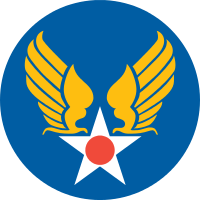Pennsylvania World War II Army Airfields
Pennsylvania World War II Army Airfields | |
|---|---|
| Part of World War II | |
| Type | Army Airfields |
| Site history | |
| Built | 1940-1944 |
| In use | 1940-present |
During World War II, the United States Army Air Forces (USAAF) established numerous airfields in Pennsylvania for training pilots and aircrews of USAAF fighters and bombers.
Most of these airfields were under the command of First Air Force or the Army Air Forces Training Command (AAFTC) (A predecessor of the current-day United States Air Force Air Education and Training Command). However the other USAAF support commands (Air Technical Service Command (ATSC); Air Transport Command (ATC) or Troop Carrier Command) commanded a significant number of airfields in a support roles.
It is still possible to find remnants of these wartime airfields. Many were converted into municipal airports, some were returned to agriculture and several were retained as United States Air Force installations and were front-line bases during the Cold War. Hundreds of the temporary buildings that were used survive today, and are being used for other purposes.
Major Airfields
Air Technical Service Command
- Connellsville MAP, Connellsville
- Now: Joseph A. Hardy Connellsville Airport (ICAO: KVVS, FAA LID: VVS)
- Olmsted Field AAF, Middletown
- 487th/496th Army Air Force Base Unit
- Was: Olmsted Air Force Base (1947-1968)
- Now: Harrisburg International Airport (IATA: MDT, ICAO: KMDT, FAA LID: MDT)
First Air Force
- Philadelphia MAP, Philadelphia, Pennsylvania
- 431st Army Air Force Base Unit (Reduced)
- Now: Philadelphia International Airport (IATA: PHL, ICAO: KPHL, FAA LID: PHL) This is the airport in Northeast Phila not the current Philadelphia International Airport in South Philadelphia.
- Reading AAF, Reading
- 390th Army Air Force Base Unit
- Now: Reading Regional Airport (IATA: RDG, ICAO: KRDG, FAA LID: RDG)
Air Transport Command
- Pittsburgh Army Air Base, Pittsburgh
- Now: Pittsburgh IAP Air Reserve Station (IATA: PIT, ICAO: KPIT, FAA LID: PIT)
Army Air Forces Training Command
- Waynesboro MAP, Waynesboro
- Contract Primary Pilot Training
- Closed, 1950 Now: non-aviation industrial site.
Other
- Other known airfields used by the USAAF were at Ebensburg, Milton, Beaver Falls and Williamsport. It has yet to be discovered what use the AAF made of those facilities.
References
- Maurer, Maurer (1983). Air Force Combat Units Of World War II. Maxwell AFB, Alabama: Office of Air Force History. ISBN 0-89201-092-4.
- Ravenstein, Charles A. (1984). Air Force Combat Wings Lineage and Honors Histories 1947-1977. Maxwell AFB, Alabama: Office of Air Force History. ISBN 0-912799-12-9.
- Thole, Lou (1999), Forgotten Fields of America : World War II Bases and Training, Then and Now - Vol. 2. Pictorial Histories Pub . ISBN 1-57510-051-7
- Military Airfields in World War II - Pennsylvania

.jpg)